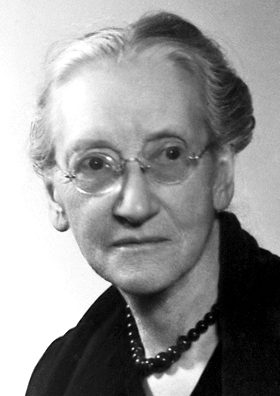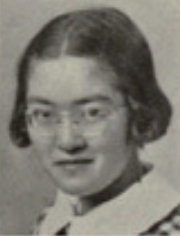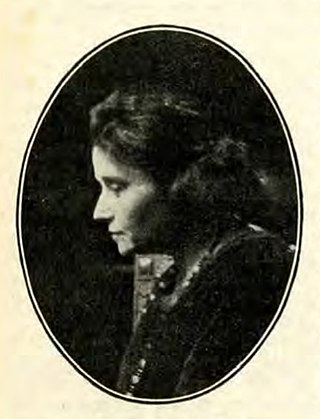
Emily Greene Balch was an American economist, sociologist and pacifist. Balch combined an academic career at Wellesley College with a long-standing interest in social issues such as poverty, child labor, and immigration, as well as settlement work to uplift poor immigrants and reduce juvenile delinquency.

The Women's International League for Peace and Freedom (WILPF) is a non-profit non-governmental organization working "to bring together women of different political views and philosophical and religious backgrounds determined to study and make known the causes of war and work for a permanent peace" and to unite women worldwide who oppose oppression and exploitation. WILPF has national sections in 37 countries.

Marii Hasegawa, born Kyogoku Marii, was a peace activist, known for her fifty years of work with the Women's International League for Peace and Freedom, including serving as its president during the Vietnam War.
Margaret Joan Holmes was an Australian peace activist, particularly during the Vietnam War and as part of the Anglican Pacifist Fellowship. She founded the New South Wales branch of the Women's International League for Peace and Freedom in 1960, and in 2001 was made a Member of the Order of Australia for her services to the community.

Lola Maverick Lloyd was an American pacifist, suffragist, world federalist and feminist. Born in Texas to the wealthy Maverick family, Lola Maverick married William Bross Lloyd, the son of muckraking journalist Henry Demarest Lloyd. Together, they leveraged their family's influence and wealth to support Progressive Era causes.

Gabrielle Duchêne was a French feminist and pacifist who was active in the French section of the Women's International League for Peace and Freedom (WILPF).
Heloise Brainerd was an American activist and a proponent of Latin American women's participation in the peace movement. Brainerd worked at the Pan American Union from 1909 to 1935 and then Women's International League for Peace and Freedom's US section. She received several international awards, including the Medal of Public Instruction from Venezuela and the Order of Merit from Ecuador.

Eugénia Miskolczy Meller was one of the most active feminists and women's rights activists in Hungary from the turn of the century to the interwar period. One of the founding members of the Feminist Association, she served as a leader for many of the organizations committees and events, arguing for gender equality, as well as women's suffrage. A pacifist, Meller worked with the Women's International League for Peace and Freedom (WILPF) arguing for disarmament and urging the passage of international laws codifying citizenship regulations to protect women. Though she had converted to Lutheranism, she was arrested when the Nazis invaded Hungary in 1944 and disappeared. In 1946, she was posthumously honored for her humanitarian works.

Gertrud Baer (1890–1981) was a German Jewish women's rights and peace activist. One of the founding members of the Women's International League for Peace and Freedom, she served as the executive secretary of the German branch of WILPF beginning in 1921 and co-chair of the international organization from 1929 to 1947. Throughout World War II, though leadership was shared, Baer was the primary leader of the organization. At the end of the war, she became the first WILPF consultant to the United Nations and held that post until 1972.

Clara Ragaz was one of the most noted Swiss feminist pacifists of the first half of the twentieth century. She was a founder of the Swiss Federation of Abstinent Women, an organization that supported the temperance movement in Switzerland. She served as the co-International chair of the Women's International League for Peace and Freedom (WILPF) from 1929 to 1946.
Kathleen Innes was a British Quaker, educator, writer and pacifist, who served as the joint chair of the international headquarters for the Women's International League for Peace and Freedom (WILPF) from 1937 to 1946.

Gertrude Carman Bussey was an American academic philosopher and activist for women's rights, civil liberties, and peace.

Louise Keilhau (1860–1927) was a Norwegian teacher and peace activist. She founded the Norwegian Committee for Permanent Peace and she was a founding member of the Women's International League for Peace and Freedom (WILPF).
Krishna Ahooja-Patel was an Indian trade unionist, women's rights activist, journalist, and pacifist who worked in various organizations such as the United Nations (UN).

Feminist peace research uses a feminist framework to expand on conventional peace research practices, examining the roles of gender and other power structures to conceptualize and actively build peace with justice. Feminist peace research understands peace and violence to be interwoven and ongoing processes that occur at many scales, and points to how these scales are interconnected. While gender is the dominant lens through which processes of peace and violence are analyzed, this research seeks to address the ways in which other intersecting systems of power, such as race, class, sexuality, and disability, among many others, further complicate these dynamics.

Yella Hertzka was an Austrian women's rights and peace activist, school director, and music business executive. She began working in women's humanitarian and social improvement projects in 1900. Co-founding the Neuer Wiener Frauenklub in 1903, she served as its president from 1909 to 1933. From 1904 she participated in the international women's rights movements, supporting women's suffrage and pacifism. In 1919, she attended the Zürich congress of the Women's International League for Peace and Freedom (WILPF). She was a co-founder of the Austrian section of the WILPF, organized its 1921 Vienna Congress, and attended every international WILPF congress held between 1919 and 1948. She worked to free prisoners of war after World War I and during World War II helped those wanting to emigrate or oppose the draft.
Camille Drevet née Bonnat was a French anti-colonialist, feminist activist and pacifist. She was an important figure in the French section of the League against Imperialism. She served as international secretary of Women's International League for Peace and Freedom (LIFPL).

Olga Bianchi Droguett (1924–2015) was an Argentine-born Chilean filmmaker, feminist, pacifist and women's rights activist. As a result of her resistance to Augusto Pinochet, she fled Chile in 1975 and settled with her children in Costa Rica. A convinced pacifist, in the early 1980s she joined Liga Internacional de las Mujeres Pro Paz y Libertad (LIMPAL), the Latin American branch of the Women's International League for Peace and Freedom (WILPF), becoming LIMPAL vice-president in 1986 and 1989. In addition, she served as LIMPAL's permanent representative to the United Nations in Geneva. Bianchi was also a board member of Amnesty International in Costa Rica and a founding member of the human rights organization CODEHU, the Costa Rican representation with the United Nations Commission on Human Rights.

Erna Prather Harris was an American journalist, businesswoman, and activist, known for her pacifism. Born in Oklahoma, she grew up in the segregated South and attended Black schools. After graduating from Douglass High School in Kingfisher, Oklahoma, she worked as a maid to earn enough money to attend an integrated university. Graduating from Wichita State University in 1936, and unable to find work, she opened her own newspaper, The Kansas Journal.

Virginia Tango Piatti was an Italian writer, pacifist, anti-fascist, and women's rights activist. Born in Florence, the family settled in Rome in 1897, where she was briefly schooled by nuns. She moved to Milan in 1904 to help with the education of her sister's children and met the painter Antonio Piatti, whom she married in 1905. Although she had begun writing around the time of her marriage, it became her livelihood in 1911, when she separated from her husband. She adopted the pen name Agar at that time, publishing poems, children's stories and articles about pacifism in various journals. Her outspokenness against fascism led to her registration as a subversive and her self-exile to Paris.















